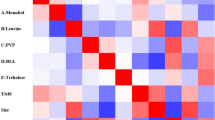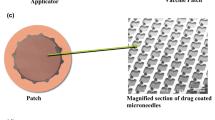Abstract
Purpose. To develop stable and effective aluminum salt (alum)-adsorbed vaccine powder formulations for epidermal powder immunization (EPI) via a spray freeze-drying (SFD) process.
Methods. Powder properties were determined using particle size analysis, tap density, and scanning electron microscopy. Alum coagulation was monitored via optical microscopy and particle sedimentation. Protein analysis was determined by the BCA protein assay, SDS-PAGE, and an enzyme immunoassay. In vivo immunogenicity and skin reactogenicity were performed on hairless guinea pigs and pigs, respectively.
Results. SFD of hepatitis B surface antigen (HBsAg) adsorbed to aluminum hydroxide or aluminum phosphate using an excipient combination of trehalose/mannitol/dextran produced vaccine powders of dense particles and satisfactory powder flowability and hygroscopicity. This formulation also offered excellent long-term stability to the powder and the antigen. The two most important factors influencing alum particle coagulation are the freezing rate and the concentration of aluminum in the liquid formulation for SFD. The SFD vaccines, when delivered to hairless guinea pigs by EPI or injected intramuscularly after reconstitution, were as immunogenic as the original liquid vaccine. A further study showed that EPI with SFD alum-adsorbed diphtheria-tetanus toxoid vaccine was well tolerated, whereas needle injection of the liquid formulation caused persistent granuloma.
Conclusions. Stabilization of alum-adsorbed vaccine by SFD has important implications in extending vaccination to areas lacking a cold chain for transportation and storage and may also accelerate the development of new immunization technologies such as EPI.
Similar content being viewed by others
REFERENCES
A. T. Glenny, C. G. Pope, H. Waddington, and U. Wallace. Antigenic value of toxoid precipitated by potassium alum. J. Pathol. Bacteriol. 29:38–45 (1926).-
R. K. Gupta. Aluminum compounds as vaccine adjuvants. Adv. Drug Deliv. Rev. 32:155–172 (1998).-
R. G. White. Concepts relating to the mode of action of adjuvants. Symp. Ser. Immunobiol. Stand. 6:3–12 (1967).-
D. Chen. Y-F, Maa, and J. Haynes. Needle-free epidermal powder immunizations. Expert Vaccine Rev. 1:265–276 (2002).-
A. F. Charest, J. McDougall, and M. B. Goldstein. A randomized comparison of intradermal and intramuscular vaccination against hepatitis B virus in incident chronic hemodialysis patients. Am. J. Kidney Dis. 36:976–982 (2000).-
A. Egemen, S. Aksit, Z. Kurugol, S. Erensoy, A. Bilgic, and M. Akilli. Low-dose intradermal versus intramuscular administration of recombinant hepatitis B vaccine: a comparison of immunogenicity in infants and preschool children. Vaccine 16:1511–1515 (1998).-
A. Sabchareon, P. Chantavanich, S. Pasuralertsakul, C. Pojjaroen-Anant, V. Prarinyanupharb, P. Attanath, V. Singhasivanon, W. Buppodom, and J. Lang. Persistence of antibodies in children after intradermal or intramuscular administration of preexposure primary and booster immunizations with purified Vero cell rabies vaccine. Pediatr. Infect. Dis. J. 17:1001–1007 (1998).-
M. Vogelbruch, B. Nuss, M. Korner, A. Kapp, P. Kiehl, and W. Bohm. Aluminium-induced granulomas after inaccurate intradermal hyposensitization injections of aluminium-adsorbed depot preparations. Allergy 55:883–887 (2000).-
A. C. Pembroke and R. H. Marten. Unusual cutaneous reactions following diphtheria and tetanus immunization. Clin. Exp. Dermatol. 4:345–348 (1979).-
D. Chen, R. L. Endres, C. A. Erickson, K. F. Weis, M. W. McGregor, Y. Kawaoka, and L. G. Payne. Epidermal immunization by a needle-free powder delivery technology: Immunogenicity of influenza vaccine and protection in mice. Nature Med. 6:1187–1190 (2000).-
D. Chen, C. A. Erickson, R. L. Endres, S. B. Periwal, Q. Chu, C. Shu, Y.-F. Maa, and L. G. Payne. Adjuvantation of epidermal powder immunization. Vaccine 19:2908–2917 (2001).-
D. Chen, K. Weis, A. Bucklen, C. A. Erickson, R. L. Endres, C. Lively, and L. G. Payne. Epidermal powder immunization induces both cytotoxic T lymphocyte and antibody responses to protein antigens of influenza and hepatitis B viruses. J. Virol. 75:11630–11640 (2001).-
D. Chen, C. Y. Zuleger, Q. Chu, Y.-F. Maa, J. Osorio, and L. G. Payne. Epidermal powder immunization with recombinant HIV gp120 induces both humoral and cellular immune responses in mice. AIDS Res. Hum. Retroviruses 18:715–722 (2002).-
M. I. Zapata, J. R. Feldkamp, G. E. Peck, J. L. White, and S. L. Hem. Mechanism of freeze–thaw instability of aluminum hydroxycarbonate and magnesium hydroxide gels. J. Pharm. Sci. 73:3–8 (1984).-
Y.-F. Maa, L. Zhao, L. G. Payne, and D. Chen. Stabilization of alum-adjuvanted vaccine powder formulation: Mechanism and application. J. Pharm. Sci. 92:319–332 (2003).-
D. Diminsky, N. Moav, M. Gorecki, and Y. Barenhol. Physical, chemical, and immunological stability of CHO-derived hepatitis B surface antigen (HBsAg) particles. Vaccine 18:3–17 (1999).-
M. Kyosuke, I. Yoshimitsu, K. Tetsuo, and O. Nobuya. Hepatitis B vaccine and method for its preparation. European Patent #0130619 (1989).-
Z. Csizer, K. Sikos, L. Bacskai, E. Niedermayer, L. Rethy, and J. Zsidai. Process for the preparation of lyophilized, adsorbed polyvalent vaccines. United States Patent #4,578,270 (1986).-
H. Costantino, L. Firouzabadian, K. Hogeland, C. Wu, C. Beganski, K. Carrisquilla, M. Cardova, K. Griebenow, S. Zale, and M. Tracy. Protein spray freeze drying. Effect of atomization conditions on particle size and stability. Pharm. Res. 17:1374–1381 (2000).-
Y.-F. Maa, P.-A. Nguyen, T. Sweeney, S. J. Shire, and C. C. Hsu. Protein inhalation powder: Spray drying vs. spray freeze drying. Pharm. Res. 16:249–254 (1999).-
Y.-F. Maa and P.-A. Nguyen. Method of spray freeze drying proteins for pharmaceutical administration. United States Patent #6,282,282 (2001).-
Y.-F. Maa and S. Prestrelski. Biopharmaceutical powders: Particle formation and formulation considerations. Curr. Pharm. Biotechnol. 1:283–302 (2000).-
C. Sonner, Y.-F. Maa, and G. Lee. Spray-freeze-drying for protein powder preparation: Particle characterization and a case study with trypsinogen stability. J. Pharm. Sci. 91:2122–2139 (2002).-
S. D. Allison, M. C. Manning, T. W. Randolph, K. Middleton, A. Davis, and J. F. Carpenter. Optimization of storage conditions of lyophilized actin using combination of disaccharides and dextran. J. Pharm. Sci. 89:199–214 (2000).-
S. J. Prestrelski, N. Tedeschi, T. Arakawa, and J. F. Carpenter. Dehydration-induced conformational transitions in proteins and their inhibition by stabilizers. Biophys. J. 65:661–671 (1993).-
H. R. Costantino, J. D. Andya, P.-A. Nguyen, N. Dasovich, T. D. Sweeney, S. J. Shire, C. C. Chung, and Y.-F. Maa. Effect of mannitol crystallization on the stability and aerosol performance of a spray-dried pharmaceutical protein, recombinant humanized anti-IgE monoclonal antibody. J. Pharm Sci. 87:1406–1411.-
H. Sueki, C. Gammal, K. Kudoh, and A. M. Kligman. Hairless guinea pig skin: anatomical basis for studies of cutaneous biology. Eur. J. Dermatol. 10:357–364 (2000).-
H. Miyauchi and T. Horio. A new animal model for contact dermatitis: the hairless guinea pig. J. Dermatol. 19:140–145 (1992).-
N. A. Monteiro-Riviere, D. G. Bristol, T. O. Manning, R. A. Rogers, and J. E. Riviere. Interspecies and interregional analysis of the comparative histologic thickness and laser Doppler blood flow measurements at five cutaneous sites in nine species. J. Invest. Dermatol. 95:582–586 (1990).--
Author information
Authors and Affiliations
Corresponding author
Rights and permissions
About this article
Cite this article
Maa, YF., Shu, C., Ameri, M. et al. Optimization of an Alum-Adsorbed Vaccine Powder Formulation for Epidermal Powder Immunization. Pharm Res 20, 969–977 (2003). https://doi.org/10.1023/A:1024493719236
Issue Date:
DOI: https://doi.org/10.1023/A:1024493719236




